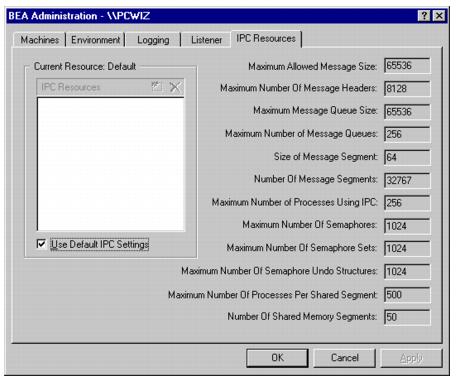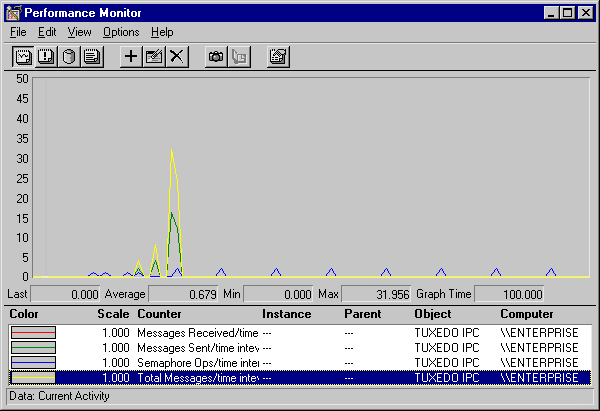2.7 Configuring and Monitoring IPC Resources to Maximize System Performance
The IPC Resources page enables you to configure the interprocess communication (IPC) resources on your Windows Server system to maximize Oracle Tuxedo performance.
Figure 2-9 Oracle Administration Window with IPC Resources Page Displayed

During the Oracle Tuxedo installation, the installer program installed an Oracle ProcMGR service on your Windows Server system. Each time you boot your system, the Oracle ProcMGR service configures the IPC resources on your machine to whatever values you set on the IPC Resources page. The values shown in the preceding display are the default IPC values set by the installer program.
On most machines, Oracle ProcMGR runs as installed; however, you can use the IPC Resources page to tune the IPC resources and maximize performance. To determine the minimum IPC Resource values required for an Oracle Tuxedo application, see “Checking IPC Requirements” in Installing the Oracle Tuxedo System. The following table maps the names of the IPC Resources on a Windows Server system to the traditional names on a UNIX system.
Table 2-1 PC Resource Name Mappings Between Windows and UNIX Systems
| Windows Server Name | Traditional UNIX Name |
|---|---|
| Maximum Allowed Message Size | MSGMAX |
| Maximum Number of Message Headers | No matching name |
| Maximum Message Queue Size | MSGMNB |
| Maximum Number of Message Queues | MSGMNI |
| Size of Message Segment | MSGSSZ |
| Number of Message Segement | MSGSEG |
| Maximum Number of Processes Using IPC | NPROC |
| Maximum Number of Semaphores | SEMMNS |
| Maximum Number of Semaphores Sets | SEMMNI |
| Maximum Number of Semaphore Undo Structures | SEMMNU |
| Maximum Number of Processes Per Shared Segement | No matching name |
| Number of Shared Memory Segments | SHMMNI |
To modify IPC Resource values using the IPC Resources page, follow these steps:
- In the “Current Resource: Default box,” click the Use Default IPC Settings check box to clear it. An insert box appears in the Current Resource: Default box.
- Click the insert box, enter the name of your Windows Server machine, and press Enter.
- Click the fields next to the IPC resources you want to change and enter the desired values.
- Click OK or Apply to write your changes to the Windows Server Registry.
- Stop and restart the Oracle ProcMGR service to put your changes into effect: click Start → Programs → Administrative Tools → Services to launch the Services window and then stop and restart the Oracle ProcMGR via the Services window.
When interpreting the Maximum Number of Processes Using IPC parameter on the IPC Resources page, keep the following information in mind:
- You must count any multicontexted Oracle Tuxedo ATMI client multiple times. Your total should match the number of application associations (contexts) that can be outstanding concurrently.
- You must count any multicontexted Oracle Tuxedo ATMI server
multiple times. Your total should match the number of contexts
calculated by adding 1 to the value of
MAXDISPATCHTHREADSin the target application’s configuration (UBBCONFIG) file, where 1 represents the main dispatcher thread.
You can view the performance of a running Oracle Tuxedo application on the Windows Server Performance Monitor. Choose Start → Programs → Administration Tools → Performance Monitor to launch the Performance Monitor window.
Figure 2-10 Performance Monitor

Parent topic: Configuring Oracle Tuxedo ATMI for Windows Server